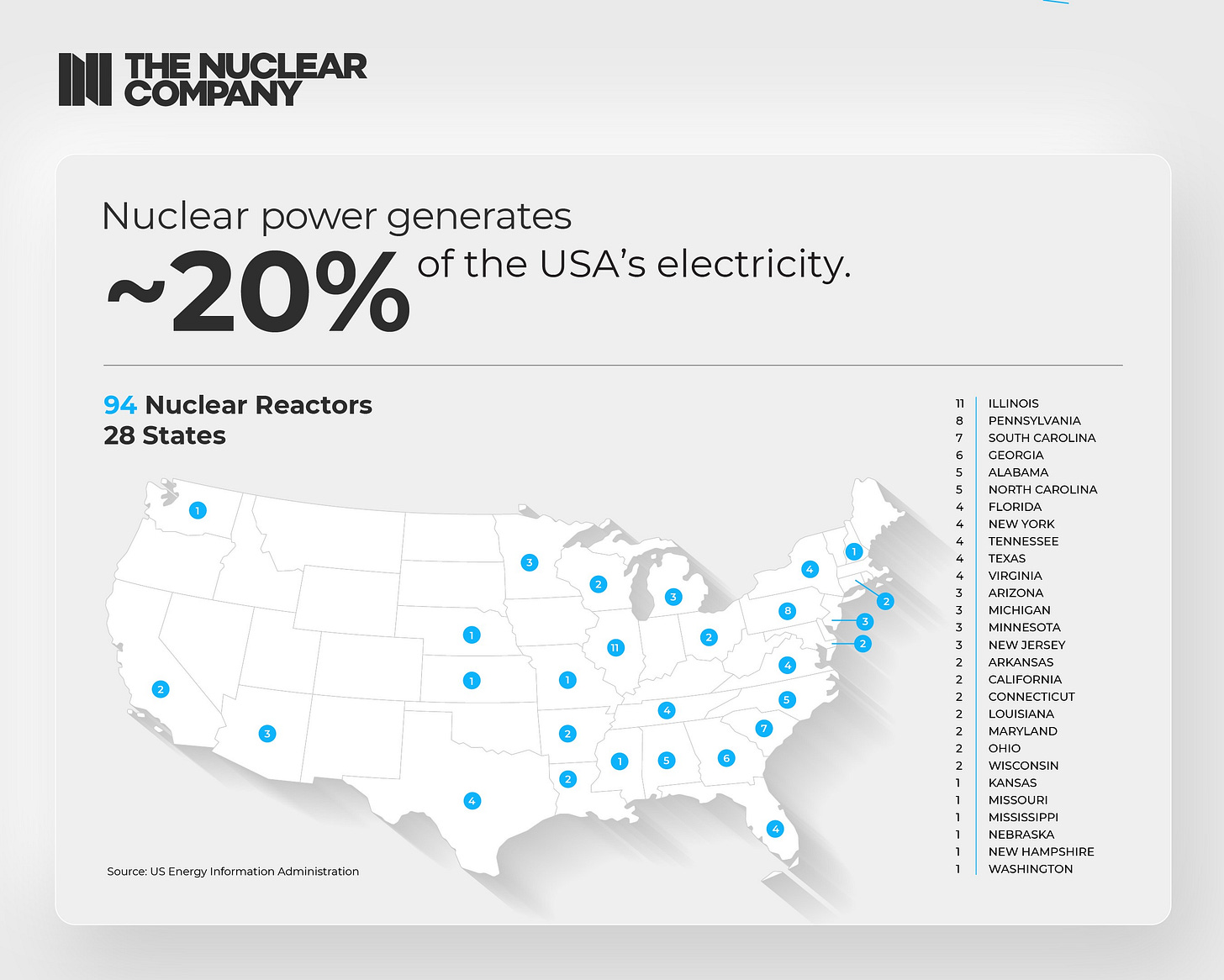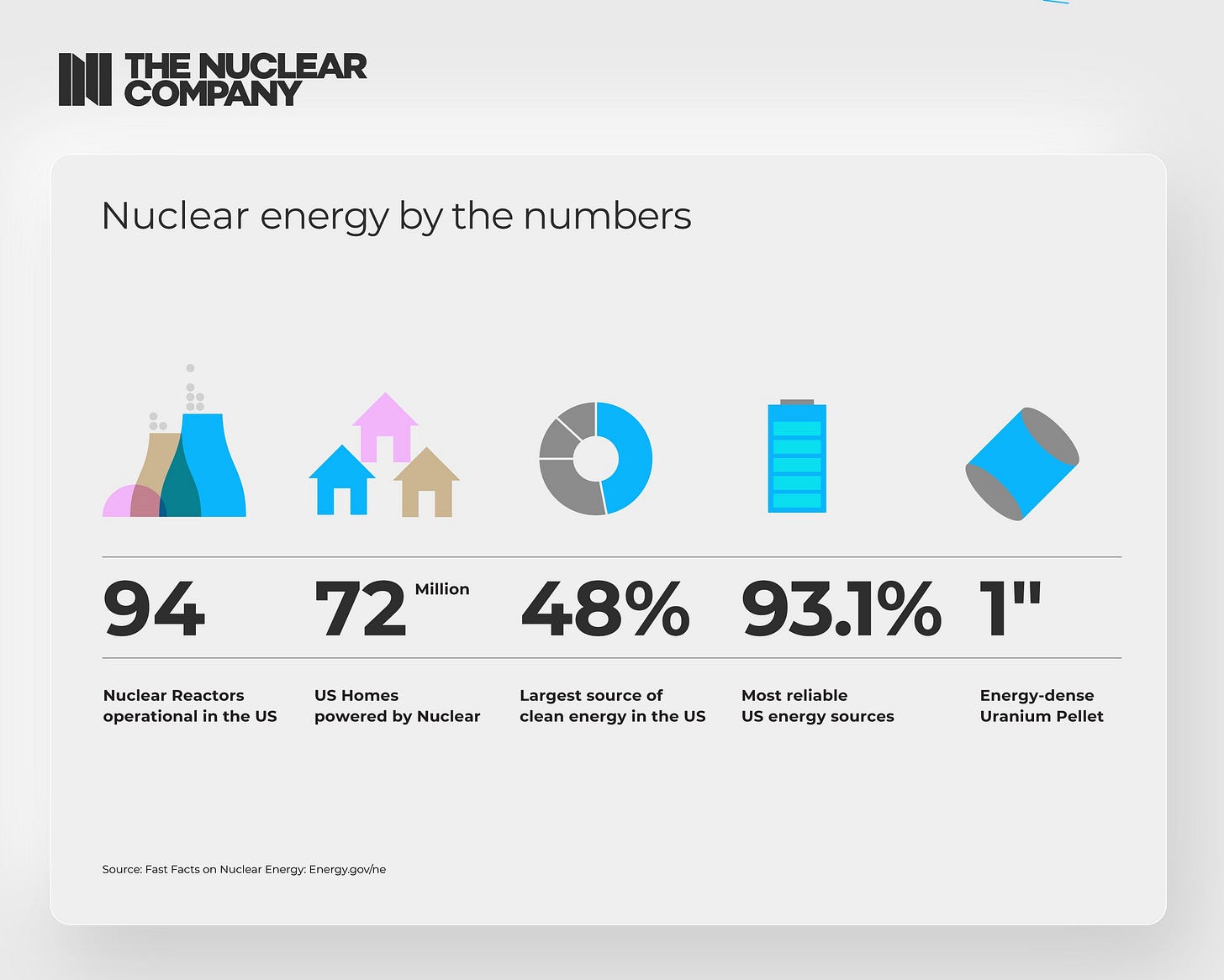Demystifying Nuclear Power: A Key to America’s Clean Energy Future
by Juliann Edwards, Chief Development Officer of The Nuclear Company
As clean, alternative energy sources continue to scale throughout the United States, nuclear power is increasingly gaining attention given its efficiency, scalability, and reliability. This has also resulted in nuclear power becoming one of just a few bipartisan issues in the country, alongside significant recent investments from tech giants to accelerate deployment. Despite the positive tides turning for nuclear, there remain a number of myths stemming from decades of misinformation and public uncertainty about the industry that need to be cleared up. Third-party research, such as a recent Pew Research Center study showing record support for nuclear power, along with strong support from communities near nuclear plants, makes it clear that nuclear power is not the dangerous energy source it has often been mischaracterized as in the past.
Communities with nuclear reactors are supportive of the high-paying jobs created by the plants and frequently note the ancillary economic benefits that come from a plant’s presence. In fact, nuclear plants create more permanent jobs than any other source of electricity. To bring this economic success to more and more communities across the country, it’s critical that our industry and supporters dispel rumors that have persisted over the years.
Myth No. 1 – Are Nuclear Plants as Dangerous as You Think?
The nuclear power industry is often boiled down to extreme events or accidents that have called plant safety into question. Despite these fears, the nuclear industry has a notably high safety record for its plants. Since 1986, no nuclear workers or members of the public have lost their lives as a result of exposure to radiation due to a commercial nuclear reactor incident.
Major nuclear accidents are exceedingly unlikely, as modern nuclear reactors are designed and developed with decades of experience to cope with any known and unknown risks. Nuclear plants have a high-quality design and construction that includes a series of provisions including physical barriers between the core and the environment. Facilities also have multiple advanced safety systems, each with backups designed to accommodate any potential human error. Sites also have comprehensive monitoring and regular testing that detects any equipment or operational failures. The small number of historical nuclear accidents caused few casualties, and improvements in technology, enhanced regulations, and rigorous safety measures make nuclear power one of the safest methods of generating electricity compared to other energy sources.
Finally, the white vapor emitted from nuclear facilities’ cooling towers is neither smoke nor radioactive pollution. It is water vapor rising from the cooling towers. Those are used as a cooling medium for the steam, which spins the turbines to create electricity.
Myth No. 2 – Nuclear Waste: A Problem with Solutions
Existing containment and storage for nuclear waste is robust, proven, and highly regulated. The licensee of a nuclear facility is accountable for the procurement and management of fuel during and after operations. This includes waste collection and sorting, reducing its volume and changing its chemical and physical composition (like concentrating liquid waste) and conditioning so the waste is properly immobilized and packaged before its storage and disposal.
When uranium fuel is done making energy, it is moved out of the reactor vessel and into pools of water contained deep within the plant to cool down for several years. It is then moved into heavy concrete and steel dry-cask containers and placed outside of the reactor buildings on the site of the nuclear plant. These concrete containers block radiation on site, are engineered to withstand disasters and protect both humans and the environment. Additionally, the International Atomic Energy Agency works directly with its member states to ensure proper safety frameworks are in place for the management and disposal of waste products. Waste management and disposal is a top priority for every stakeholder in the industry – from government and licensees to administrators and workers in the facility.
Myth No. 3 – Exporting Power: Nuclear’s Global Role
Nuclear power has seen rising interest and demand due to its ability to generate 24/7 clean, firm baseload power that supports growing global AI and data center needs. In just the past two months, three tech giants — Microsoft, Google and Amazon — have all announced large deals to have nuclear power their AI data centers. However, this isn’t the only use case for nuclear power.
Nuclear has a number of applications in the medical field, including uses in radiotherapy treatments, radioactive tracers to assess bodily functions and for medical diagnoses. Beyond those, numerous medical supplies are sterilized using nuclear isotopes. Specifically, the Nuclear Energy Institute found that the radioisotope cobalt-60 that is manufactured in some nuclear reactors is used to sterilize approximately 40% of single-use medical devices globally. These devices include such common items as syringes, catheters, IV sets, surgical gloves, and gauze that are used in a wide range of healthcare applications. Other important uses of cobalt-60 include the non-invasive treatment of cancers and brain tumors, polymer processing, food treatment and environmental applications.
Nuclear is also behind some of our most exciting developments in space exploration, including powering rovers on Mars. NASA’s Space Nuclear Propulsion Office has been working for years to revolutionize space travel by developing new propulsion systems using nuclear power to accelerate and advance space exploration. By using nuclear power, spacecraft can make more rapid transits, providing samples for more thorough research and understanding of the world around us — and all with minimal need for refueling and maintenance. Without nuclear power, our achievements in space exploration may not have been possible.
If the United States fails to react, it may risk missing out and permanently ceding its leadership in the civil nuclear export market to Russia and China
Beyond the above, building out a world-leading nuclear power supply chain can create high-paying manufacturing jobs in America. Russia, and more recently China, have taken advantage of America’s inaction and become world leaders in nuclear technology. The Council on Foreign Relations noted Russia “has become unrivaled in the global nuclear power export market” and “also dominates nuclear fuel supply chains.” In the same report, the Council on Foreign Relations estimated that expansion by U.S. nuclear power suppliers could generate between $1.3 trillion and $1.9 trillion. “If the United States fails to react, it may risk missing out and permanently ceding its leadership in the civil nuclear export market to Russia and China,” the report noted.
Ending the Myths
In an increasing age of misinformation, where decisions will be made without the proper information or knowledge, it’s crucial that people have an accurate understanding of what the modern nuclear industry looks like, rather than decades-old perceptions that have been passed down to them. Nuclear is the clean energy source that can help restore America’s leadership in global energy production. As we’re in the midst of a nuclear renaissance, more and more businesses and consumers are championing nuclear power.
🎙️ Inevitable Podcast
✨ Halen Mattison and Luke Neise, co-founders of General Galactic, are turning space-age technology into a climate solution here on Earth. Their seed-stage startup is pioneering e-fuels by converting captured CO₂ into synthetic fuels—starting with natural gas. In this episode, they share how innovations designed for space travel inspired their vision for reshaping the energy transition.
🍿 The Lean Back
Learn more about Idaho National Lab in this episode of the MCJ podcast.
👩💻 Climate Jobs
For more open positions, check out the Job Openings space in the MCJ Collective member hub or the MCJ Job Board.
Finance Intern at AMP Robotics (Remote)
Product Manager, Cloud Infrastructure (Network Specialist) at Crusoe (San Francisco, CA)
Head of Sales at David Energy (Remote)
Principal Mechanical Engineer at Mantel (Cambridge, MA)
Customer Success Manager - Commercial Office at Mill (New York, NY)
Finance Analyst at Odyssey Energy Solutions (Remote)
Power Engineer at Paces (Brooklyn, NY)
Staff Software Engineer, Android at Quilt (Redwood City, CA)
Senior Engineering Director, Plant Development at Twelve (Remote)
👩💻 Events
🤖 MCJ + Climate People: Leveraging AI in your Climate Job Search: Led by Yvonne Espinosa and Anita Kelava of Voiz Academy, this session will transform your job search strategy through practical, AI-powered techniques. We'll explore how AI can help you identify key requirements, uncover employers' priorities, and tailor your pitch for your target positions. (Feb 19)
🗽 Women of MCJ NYC Happy Hour: Join the women of MCJ for an intimate happy hour in honor of Galentine's Day. Come through, reconnect with old friends, make some new ones, and dust off the winter doldrums with MCJ. (Feb 20)
The MCJ Newsletter is a FREE weekly email curating news, jobs, Inevitable podcast episodes, and other noteworthy happenings in the MCJ Collective community.
💭 If you have feedback or items you’d like to include, feel free to reach out.
🤝 If you’d like to join the MCJ Collective, apply today.
💡 Have a climate-related event or content topic that you'd like to see in the MCJ newsletter? Email us at content@mcj.vc





MCJ, why are you lending your channel to an incomplete, clearly biased and laughably transparent shill from a nuclear company that doesn’t even mention a fundamental challenge nuclear continues to face: cost? From someone who claims “$16B clean energy build out” from a prior role trying to make Transcanada look good, no less?
“Sponsorship” $$$ to carry it?
Nuclear has real strengths, risks, and barriers. This undermines an effective discussion of all of those, and destroys your credibility.
Other channels have the integrity to clearly label sponsored content. You can do so much better, MCJ team. We need you to do better to effectively address the scale of the challenge and opportunity we face.
I hope and believe you can.
Let's see what Indigenous people have to say about this. They've got a strong historical interest, looking backwards and forwards. There is a range of perspectives, of course, but to expand this conversation, check out November's "Assembly of First Nations (AFN) Bulletin – Final Report on 2024 Dialogue Sessions and Recommendations to the Nuclear Waste Management Organization (NWMO)."
Overview at https://afn.ca/all-news/bulletins/assembly-of-first-nations-afn-bulletin-final-report-on-2024-dialogue-sessions-and-recommendations-to-the-nuclear-waste-management-organization-nwmo/
The full report includes 8 recommendations, the first being:
"The AFN respectfully urges that comprehensive and meaningful dialogue, consultation, and engagement be undertaken with all affected First Nations throughout the site selection process, and before any critical decisions are made regarding the Deep Geological Repository or transportation routes. It is essential that the perspectives of all First Nations who rely on the same watershed as the proposed site, as well as those along the transportation route, be respected and fully integrated, in a manner that honors their inherent right to self-determination. This approach will ensure a more inclusive and equitable process for all."
The second is "The AFN strongly urges that robust First Nations-led emergency response plans and communication systems be developed and implemented prior to site selection and the transportation of nuclear waste through First Nations lands. This includes comprehensive source water protection measures for First Nations."